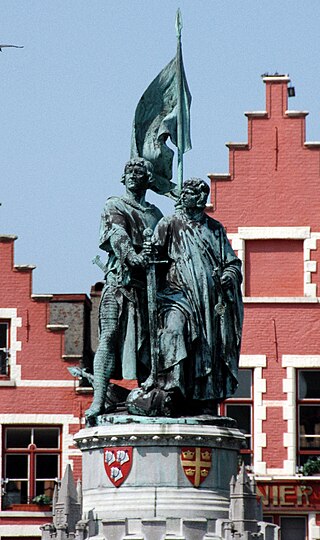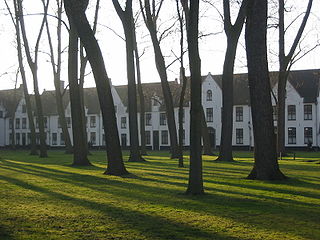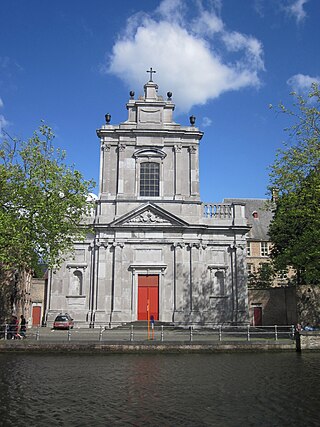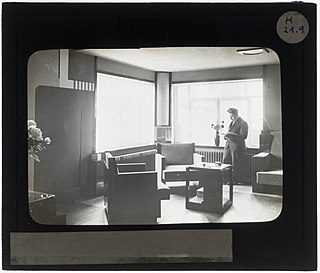

Eekhout Abbey (Dutch : Eekhoutabdij) was a medieval house of Augustinian Canons in Bruges, West Flanders, Belgium.


Eekhout Abbey (Dutch : Eekhoutabdij) was a medieval house of Augustinian Canons in Bruges, West Flanders, Belgium.
The origin of the abbey, dedicated to Saint Bartholomew, was traditionally linked to the religious community that had grown up round the cell of the hermit Everelmus in about 1050, although the first reference dates only from 1130. [1]
In or around 1146 it joined the Arrouaisian Order, and in consequence adopted the Rule of St. Augustine and became an abbey, under the first abbot, Lambertus. The men's and women's communities which had previously coexisted here were separated: the women were moved to premises in Odegem (now Steenbrugge) where their community developed into St. Trudo's Abbey (still extant and housed since 1954 in Male Castle), while the men remained on the existing site near the centre of Bruges.
After centuries of decline, the abbey was dissolved in the French Revolution.
In 1803, after being sold off as state property, the abbey was entirely demolished by its French purchaser Rousseau, except for a single doorway onto the Eekhoutstraat, which still stands. Isolated plots which were connected to their property in the Garenmarkt came into the hands of the Du Jardin family. After the failure of their family business, the Bank Du Jardin, in 1874 a large part of their property here came into the possession of the Sisters of the Sint-Andreasinstituut, who had a school built on it. The site of the former abbey is now occupied by the Groeningemuseum.

Club Brugge Koninklijke Voetbalvereniging, known simply as Club Brugge, is a Belgian professional football club based in Bruges, Belgium. It was founded in 1891 and its home ground is the Jan Breydel Stadium, which has a capacity of 29,042. They play in the Belgian Pro League, the top domestic league in Belgian football.

Jan Breydel is credited with leading the Bruges Matins, a violent uprising against Philip the Fair. He is said to have played a major role in the Franco-Flemish War, even though his authenticity has since been questioned.

The Gruuthuse manuscript is a medieval compilation, the oldest core of which is dated about 1395, while the youngest unfinished contributions date from around 1408. The manuscript is the only known source for a large number of Middle Dutch texts.

François-Joseph Kinson, was a Flemish painter.
St. Andrew's Abbey, Bruges was a Benedictine abbey in Sint-Andries, Bruges, Belgium, which was destroyed in the French Revolution. Its modern successor St. Andrew's Abbey, Zevenkerken, founded in 1899–1900, is a Benedictine abbey of the Congregation of the Annunciation.

Count Hieronymus Lauweryn van Watervliet, or Jerome Laurinus of Watervliet, was a courtier at the court of Philip the Handsome, to whom Lauweryn was treasurer. He was also a courtier at the courts of Maximilian I, Holy Roman Emperor, and of Margaret of Austria.

Bruges is the capital and largest city of the province of West Flanders in the Flemish Region of Belgium, in the northwest of the country. It is the sixth most populous city in the country.

The Exposition des primitifs flamands à Bruges was an art exhibition of paintings by the so-called Flemish Primitives held in the Provinciaal Hof in Bruges between 15 June and 5 October 1902.

The Princely Beguinage Ten Wijngaerde is the only preserved beguinage in Bruges, Belgium. There are no more beguines living there, but since 1927, it has functioned as a convent for Benedictines, founded by canon Hoornaert. In the same year, the houses at the west side were also reshaped and enlarged into the Monasterium De Wijngaard, a priory of Benedictine nuns.
Everelmus was a hermit in the vicinity of Bruges. His hermitage, on an island in the river Reie, lay at the basis of the later Eekhout Abbey.

Ten Putte Abbey is a monastery with an abbey in Gistel, roughly 8 km to the south of Ostend, in the western part of Belgium. It was built to mark the spot where, in 1070, Saint Godelina was murdered by strangulation and then thrown into a pond. Before 2007 the abbey was home to nine Benedictine nuns, who were members of the wider Subiaco Cassinese Congregation in West Flanders. Since 2007 it has been occupied by brothers and sisters of the "Mother of Peace" community.

Male Castle, Bruges. A community of the Canonesses Regular of the Holy Sepulchre. It originated in Bruges in the 11th century, and between 1954 and 2013 was settled in Male Castle in Male, Sint-Kruis, Bruges, West Flanders, Belgium.
CornilCacheux was a French pipe organ maker.

The Major Seminary in Bruges, in Dutch Grootseminarie, is a centre for training and formation in the Roman Catholic Diocese of Bruges, formerly used as the seminary for preparing candidates for the diocesan priesthood. It is located on the Potterierei in Bruges.

Pieter Bladelin was an important financial advisor and civil servant to the Burgundian State. He was lord of Middelburg and built the Hof Bladelin in Bruges.

Mathias Lambrecht (1539–1602) was the third bishop of Bruges.

The Burg is a square and former fortress in Bruges, West Flanders, Belgium. It is one of the main squares of the city.

Hubrecht (Huib) Hoste was a Belgian architect, designer and urban planner. He is considered the pioneer of modern architecture in Belgium.
Edward Still is a football manager. He has managed Charleroi, Eupen and Kortrijk in the Belgian Pro League, starting at age 30.